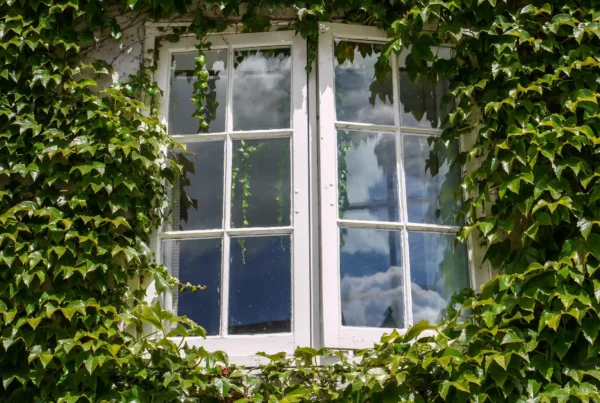As we provide window cleaning services, we know a thing or two about window glazing too!
Secondary glazing and double glazing are two different types of window solutions that can improve the thermal and acoustic performance of buildings. If you currently have single glazing and are in the decision-making process of whether to upgrade to double-glazed, or choose secondary glazing solutions, you’re in the right place.
Here, we’ll go through the difference between secondary glazing and double glazing and the pros of choosing one over the other. By the end of the article you should be in a much better position to make an informed decision on whether secondary glazing or double glazing is right for you.
But first, let’s start with the basics of single glazing, secondary glazing, and double glazing.
What is single glazing?
Single glazing refers to a type of window that consists of a single pane of glass. Single-glazed windows were the standard for many years before the development of double-glazing. They are still found in older buildings and in some modern buildings, although they are much less common than they used to be.
Single glazing offers little in the way of insulation, and as a result, can be a significant source of heat loss in buildings. It also provides poor acoustic insulation, which can be a problem in noisy environments. Single-glazed windows are more prone to condensation and can be less secure than double-glazed windows.
Despite their drawbacks, single-glazed windows can have aesthetic or architectural value and may be preferred in historic or listed buildings where preserving the original windows is a priority.

What is secondary glazing?
Secondary glazing is a window system that involves installing a supplementary glazed unit on the inside of an existing single-glazed window. The supplementary unit can be made of glass, acrylic or polycarbonate, and is fitted to the window frame using brackets or magnetic strips. The aim of secondary glazing is to improve the thermal and acoustic performance of the existing window by creating an additional barrier against heat loss and noise transmission.
What is double glazing?
Double glazing is a type of window system that consists of two panes of glass separated by a sealed air gap. The sealed air gap creates an additional layer of insulation that reduces heat loss, improves energy efficiency, and minimizes noise transmission. The two panes of glass can be either annealed or tempered glass, and the air gap can be filled with an insulating gas, such as argon or krypton, to enhance the thermal performance of the window.
Double glazing is a popular choice for modern buildings as it offers many benefits, including improved energy efficiency, noise reduction, and increased security. It can also reduce condensation on windows and help to regulate indoor temperatures, making it a comfortable environment to live or work in. Double glazing can be installed in a variety of window styles, including casement, sliding, and tilt-and-turn windows. It is a reliable and durable solution that can last for many years with minimal maintenance.
Secondary glazing vs double glazing: Which should you choose?
Now we know the difference between single glazing, secondary glazing, and double glazing, let’s dive into the reasons why would someone choose secondary glazing over double glazing and vice versa.
A quick recap on the definition: Double glazing is a window system consisting of two panes of glass with a sealed air gap between them, while secondary glazing is a supplementary window system installed on the inside of an existing single glazed window.
- Insulation
Both double glazing and secondary glazing provide insulation to the building, but the degree of insulation differs. Double glazing provides better insulation than secondary glazing because the sealed air gap between the two panes of glass creates a barrier that reduces heat loss and noise transmission.
- Installation
Double-glazing windows require complete removal and replacement of the existing single-glazed windows, whereas secondary glazing can be installed on the inside of the existing windows. Secondary glazing is often the preferred option for listed buildings, conservation areas, and heritage buildings where the existing windows cannot be replaced.
- Cost
Double-glazing windows are typically more expensive than secondary-glazing windows because they require a complete replacement of the existing windows. However, the cost of secondary glazing can vary depending on the type of glazing material used, the size of the window, and the installation method.
The cost of secondary glazing in the UK can vary depending on a range of factors, such as the size of the windows, the type of glazing material, the level of customisation required, and the complexity of the installation.
As a rough guide, the cost of secondary glazing can be around the £5,000 mark for a three-bedroom house, depending on the factors mentioned above.
The cost of double glazing in the UK also varies depending on a number of factors, but is expected to be anywhere between £6,000 – £15,000 for a three bedroom house.
It’s worth noting that secondary glazing is generally less expensive than double glazing because it does not require the complete replacement of the existing windows. However, it’s important to keep in mind that the long-term cost savings of secondary glazing may not be as significant as those of double glazing, as secondary glazing may not be as effective at reducing heat loss and improving energy efficiency.
To get an accurate idea of the cost of secondary glazing for your specific requirements, it’s best to obtain quotes from reputable glazing companies. They will be able to provide a more accurate estimate based on the specifics of your project.
- Maintenance
Both double glazing and secondary glazing require minimal maintenance. Double glazing is more durable and requires less maintenance as the sealed air gap between the two panes of glass prevents the build-up of condensation. Secondary glazing, on the other hand, may require periodic cleaning and adjustment of the panels to maintain its performance.
- Noise reduction
Double glazing windows provide better noise reduction compared to secondary glazing windows, as the sealed air gap between the two panes of glass acts as a sound barrier.
- Aesthetics
Double glazing windows have a more modern and sleek appearance compared to secondary glazing, which may be visible from the inside of the building. However, secondary glazing can be customized to match the existing window frames and may be a better option for buildings with specific aesthetic requirements.
In summary, double glazing has the edge with the winners of each category listed below:
Insulation winner: Double glazing
Installation winner: Secondary glazing
Cost winner: Secondary glazing
Maintenance winner: Double glazing
Noise reduction winner: Double glazing
Aesthetic winner: Double glazing
Overall, secondary glazing is a practical and cost-effective solution for improving the thermal and acoustic performance of buildings, particularly in situations where double glazing is not feasible or desirable. However, if preservation of the building is not required by law, you’re not on a tight budget, and you’re looking for a sleek, long lasting solution, double glazing would be our recommended choice.



